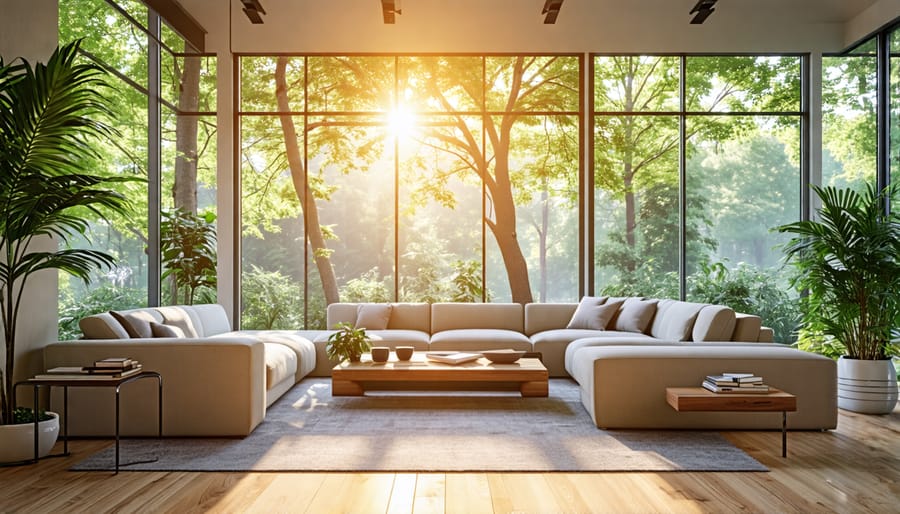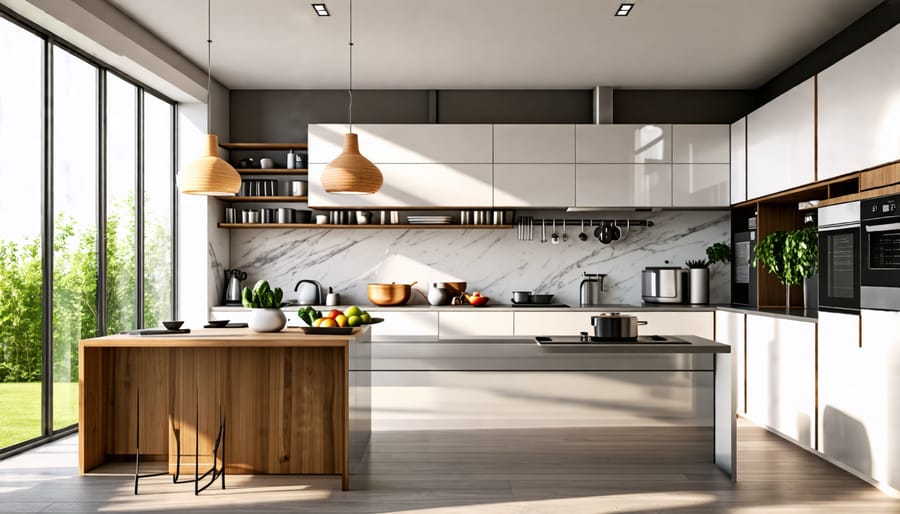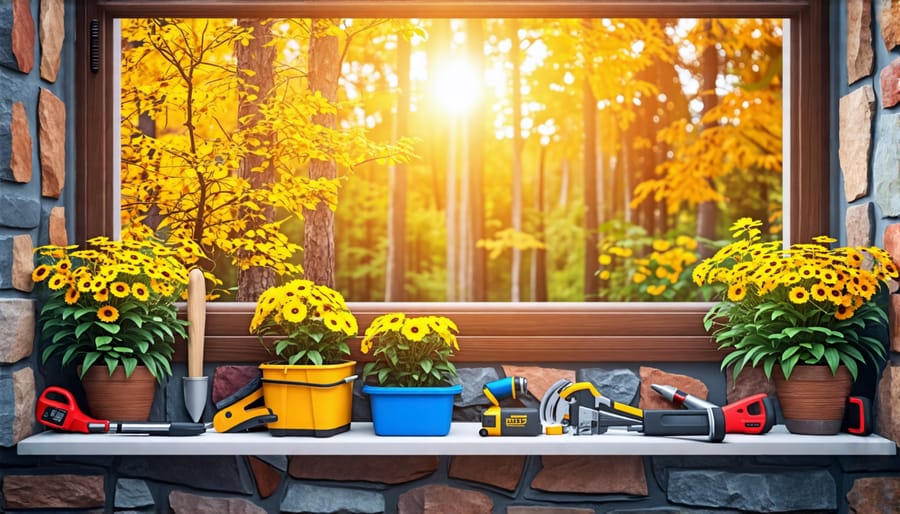Install energy-efficient LED bulbs to immediately cut down electricity use and extend bulb lifespan. Seal windows and doors with weatherstripping to prevent drafts and reduce heating costs. Implement smart thermostats to monitor and optimize home temperature settings effortlessly. Evaluate insulation quality in your attic and walls; upgrading can greatly enhance temperature retention. Begin transforming your space into an energy-efficient home.
Understanding Energy Efficiency at Home
Energy efficiency in the home is all about using less energy to perform the same tasks, reducing waste and saving money while minimizing your environmental footprint. Whether you’re a homeowner or a renter, understanding and enhancing energy efficiency can make a significant impact on your monthly bills and contribute positively to the planet. Imagine reducing your energy consumption just by making a few small changes around the house—it’s both empowering and rewarding!
For homeowners and renters alike, embracing energy efficiency means starting with simple actions, like adjusting your thermostat and sealing drafts around windows and doors. By making these small adjustments, you can keep your home warm in the winter and cool in the summer without overusing your heating and cooling systems. Think about swapping out older appliances for energy-efficient models. These may require a bit more investment initially but can lead to substantial savings over time.
Lighting plays a key role too; switching to LED bulbs can cut lighting costs significantly and they last much longer. Don’t forget, energy efficiency isn’t only about cutting costs—it’s about creating a more sustainable way of living. By understanding and implementing these practices, you’re setting yourself up for a more efficient home that benefits both your wallet and the wider world.
Top Energy Efficiency Strategies for Every Corner of Your Home
Living Room: Maximize Natural Light and Ventilation
Maximizing natural light and ventilation in your living room is a fantastic way to cut down on energy use while enhancing comfort. Start by ensuring your windows are spotless to let in as much sunlight as possible—you can refer to a handy window cleaning guide for quick tips. Consider using sheer curtains instead of heavy drapes to allow light to filter through without sacrificing privacy.
Strategically placed mirrors can amplify daylight by reflecting sunlight deeper into the room. Keep furniture low-profile and avoid blocking windows to ensure nothing hinders the flow of light and air.
For ventilation, opening windows on opposite sides of the room creates natural cross-ventilation, effectively cooling your space without the need for air conditioning. Ceiling fans are an energy-efficient addition that can help circulate air, maintaining a comfortable temperature. By harnessing these simple but effective strategies, you not only reduce your energy bill, but also create a fresh and inviting living space.

Kitchen: Optimize Appliance Use
Choosing energy-efficient appliances for your kitchen can significantly cut down on your energy bills while being kinder to the environment. Start by looking for appliances with the Energy Star label; these models meet strict energy efficiency guidelines set by the government. For instance, swapping out an old refrigerator for a new Energy Star model could save you up to 15% on energy use.
To use your appliances effectively, consider some easy hacks. For your fridge, keep it stocked but not overcrowded; a full fridge retains cold better than an empty one, optimizing energy use. When cooking, using smaller appliances like toaster ovens or microwaves for smaller meals can also cut down on energy.
Don’t forget about maintenance—clean the refrigerator coils regularly to keep it running efficiently and always cover pots while cooking to speed up meal prep. Little changes like these not only make a big difference in energy use but also extend the life of your appliances.

Bedroom: Smart Heating and Cooling Tips
Creating a comfortable and energy-efficient bedroom can be easier than you think with just a few smart adjustments. Start by installing a programmable thermostat to optimize the temperature based on your schedule, warming up the room right before wakeup time or cooling it before sleep. Consider ceiling fans; they can effectively circulate air in both warm and cool seasons, making your HVAC system work less intensively. Also, don’t forget to ensure your windows and doors are properly sealed to prevent drafts — a simple DIY weather-stripping solution can make a noticeable difference.
If you’re using air conditioning, remember that regular maintenance is key to efficiency; check out these essential Air conditioner tips to keep it running smoothly. Lastly, curtains or blinds that block or reflect sunlight can reduce the burden on your heating and cooling systems, maintaining a cozy retreat without cranking up the energy use. By combining these strategies, you’ll enjoy a comfortable bedroom year-round while keeping your energy bills in check.
Bathroom: Water and Energy Saving Techniques
Saving water and energy in the bathroom can be simpler than you think, with benefits that not only reduce your bills but also contribute positively to the environment. Start small by fixing any leaky faucets—a simple DIY project that can prevent unnecessary water wastage. Installing a low-flow showerhead is an easy change that conserves water while maintaining water pressure, working wonders for efficiency. Did you know that turning off the tap while brushing your teeth can save up to 200 gallons of water per month? It’s a small step with a big impact.
Switching to LED lighting fixtures is another savvy move, using far less energy and lasting longer than traditional bulbs. Don’t overlook the water heater; try setting it to a lower temperature to save energy without sacrificing comfort. For more ambitious projects, consider installing a dual-flush toilet, which gives you control over water use with each flush. Each of these tweaks is a step towards a more eco-friendly home and a smaller carbon footprint.
DIY Energy Efficiency Projects
Seal and Insulate Windows and Doors
Improving insulation around your windows and doors is a simple DIY project that can make a significant impact on energy efficiency. Start by checking for drafts on a breezy day. Simply hold a lit candle or incense stick near the edges of your windows and doors; if the flame flickers, it indicates a draft. Begin sealing these gaps by applying weatherstripping tape around door frames and window sashes. This tape is adhesive and easy to install, sealing gaps where air can escape. For larger gaps, consider using a foam weatherstripping product, which provides more cushioning and better insulation.
Don’t forget to caulk around window and door frames, sealing any visible cracks. Choose a high-quality, weather-resistant caulk for a lasting solution. If you notice that your door sweeps or thresholds are worn out, replacing them might also be necessary. New door sweeps can help block drafts at the bottom of the door, further enhancing insulation. With these expert tips, you can create a more energy-efficient home that feels cozier year-round.

Installing Energy-Efficient Lighting
Ready to brighten your home and save on energy costs? Choosing and installing LED lighting is a simple DIY project that can make a big difference. Start by assessing key areas of your home like the kitchen, living room, and bathrooms. These high-traffic spots will benefit the most from efficient lighting. When selecting LEDs, look for options with the ENERGY STAR label for quality assurance. Choose bulbs with a warm or cool tone depending on your room’s color scheme and desired ambiance.
Next, measure the current light fixtures to ensure compatibility. Most LEDs fit standard fixtures, but checking sizes can save you a trip back to the store. Once you have your bulbs, turn off the power for safety. Replace existing bulbs with your new LEDs, ensuring they’re securely in place. Finally, flick the switch to test them out. Not only should you notice an instant improvement in brightness, but you’ll also be cutting down on energy usage, one bulb at a time. Enjoy your well-lit, eco-friendly home!
Expert Tips for Long-Term Energy Efficiency
Regular Maintenance and Upkeep
Regular maintenance and upkeep are pivotal for achieving optimal energy efficiency in your home. Routine checks on appliances, heating systems, and insulation help ensure everything runs smoothly and efficiently. By replacing air filters in your HVAC system every 1-3 months, you can maintain good airflow and reduce strain on the system, ultimately cutting down energy consumption. A simple DIY project like sealing leaks around windows and doors with weatherstripping can also make a significant difference. Regularly cleaning refrigerator coils not only keeps your fridge running efficiently but also prolongs its life. These small, proactive steps can lead to substantial energy savings over time, ensuring your home’s energy systems remain efficient and reliable.
Stay Informed About New Technologies
Staying informed about new technologies in energy efficiency can make a big difference in how you save energy at home. As innovations rapidly emerge, consider subscribing to newsletters from reputable energy organizations or setting up Google Alerts for related keywords. Attending home improvement expos or virtual workshops can also keep you up to date. Following experts and influencers on social media platforms can provide insights and real-life examples of effective solutions. Keeping a curious mindset and exploring new tools and technologies not only empowers you to make smarter energy choices but also boosts your home’s comfort and lowers energy bills over time.
Conclusion
In wrapping up our exploration of energy efficiency, it’s clear that even small changes can have a significant impact on reducing energy consumption and expenses. We’ve delved into strategies ranging from easy DIY projects to expert tips that target every nook of your home. By adopting these strategies, not only can you enhance your living environment, but also contribute positively to the planet. So why wait? It’s time to take these insights and start transforming your home into a greener, more efficient space. Remember, every step counts, and your journey towards an energy-efficient home begins today.